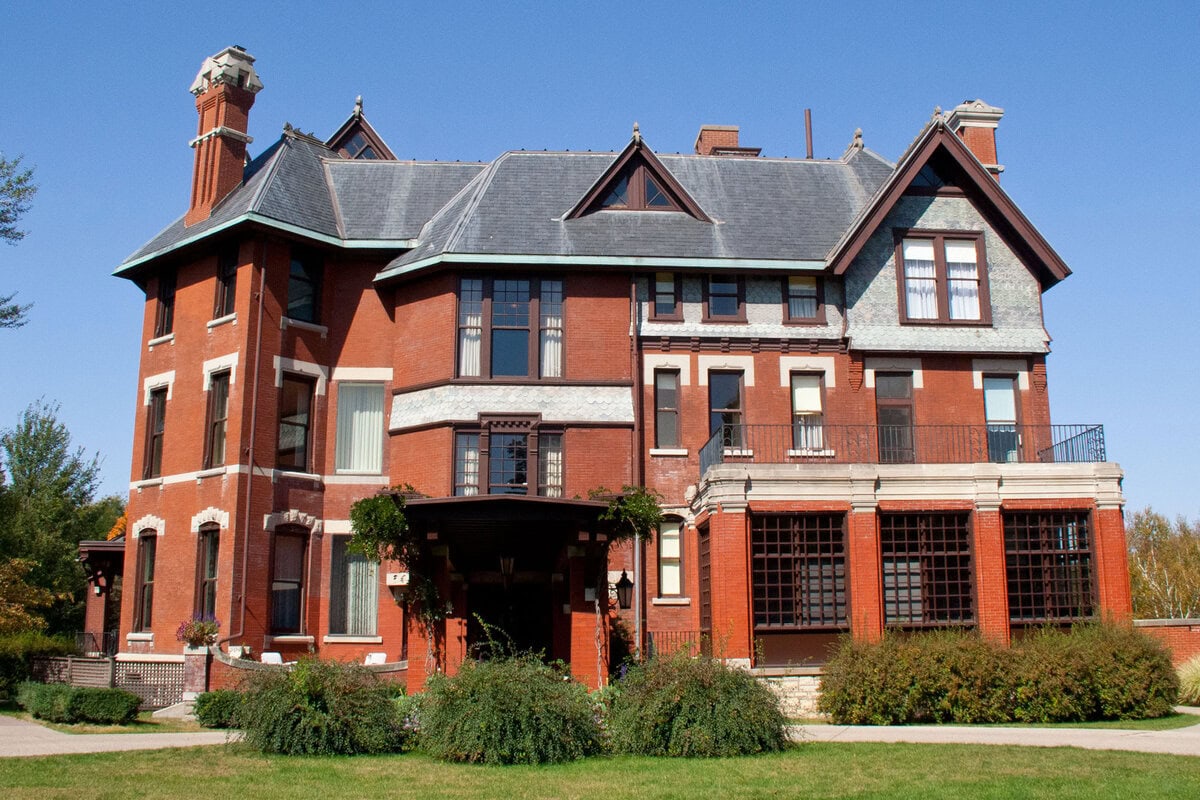Planning a Revolving Cellblock, 1883‑1885
As you stroll through the streets of Council Bluffs, Iowa, the unique structure of the Squirrel Cage Jail is bound to catch your eye.
Its Victorian style and detailed brickwork might even fool you into thinking it’s a relic of a rich past, perhaps the residence of a prominent businessman. But the truth is far more intriguing.
From the outside, it looked like a squat red fortress. But on the inside? Something spun.
Visitors walking into the Squirrel Cage Jail today might pause under the same brick lintel where county officials first inspected their brand-new lockup in 1885.
The building still stands at 226 Pearl Street in Council Bluffs, Iowa, wedged between the former courthouse lot and the tracks that shaped the city’s downtown.
This wasn’t a typical holding space.
Inside those walls, a hand crank once rotated a steel drum of cells—thirty-six of them—stacked three stories high.
That design came from a Midwestern patent shared by William H. Brown and Benjamin F. Haugh of Indianapolis.
Pottawattamie County hired their firm for the job, and the cost ran to about $30,000—a large sum in 1885, equivalent to well over $900,000 today by purchasing power.
The project broke ground early that year and wrapped up ahead of schedule, just months before work began on the county’s new courthouse across the street, completed in 1888.
The layout followed a security-first mindset. A single guard could monitor the entire rotating mechanism from one spot.
Pie-shaped cells—wedge-thin at the hinge and wide at the outer wall—turned around a central gear.
This setup allowed only one door to line up at a time, keeping the rest sealed in place.
That same principle appeared in seventeen other jails across the U.S., but none rose above two floors.
The Council Bluffs version was the only three-story rotary jail ever built.
By 1885, rotary incarceration had reached a mechanical peak.
By placing the jail next to the courthouse, Pottawattamie County made it clear that justice—and its machinery—should operate side by side.
For people looking for things to do in Council Bluffs, Iowa, that machinery is still there, preserved and immobile, but unmistakable.
Running the Wheel, 1885‑1969
The core of the jail held the three-level rotary drum.
It wasn’t automated—an officer had to use a hand crank to line up each cell with the only entry point.
That meant anyone inside the wheel couldn’t leave or even see out unless the mechanism turned.
Cells took a wedge shape, like slices of pie, each with steel bars and a curved wall.
The middle shaft anchored the spin; iron teeth guided its path.
This gear-driven model was supposed to keep movement low, staff needs minimal, and inmate interaction controlled.
The front section of the building had other uses. There was a kitchen. Women’s quarters were located up front, separate from the rotating drum.
Trustees—usually prisoners with work duties—stayed in different cells altogether.
The jailer’s office sat near the main entrance, closer to Pearl Street, and often doubled as a reception desk.
Despite its bold layout, maintenance wasn’t easy. Mechanical wear slowed the rotation over the years.
By the 1950s, moving the wheel took noticeable effort.
A few other rotary jails had already shut down by then.
Of the eighteen built, most were in the Midwest—Gallatin, Missouri, and Crawfordsville, Indiana, had smaller versions, but Council Bluffs kept the tallest.
The wheel finally stopped in 1969.
That same year, Pottawattamie County moved its prisoners to a newer facility, and the old steel drum, intact but no longer turning, came to rest.

From Lockup to Public Access, 1969‑1977
After it closed, the building sat quiet. For a while, there wasn’t a clear plan.
The Council Bluffs Park Board stepped in on June 22, 1971, taking ownership from the county to avoid demolition.
That kept the structure intact while officials sorted out the next steps.
Nothing had spun in two years, but the gears hadn’t been removed either.
Then came the paperwork. On March 16, 1972, the Squirrel Cage Jail was listed on the National Register of Historic Places.
That listing gave it formal recognition but no operating budget.
For a few years, the building was in limbo—protected but closed to the public.
In 1977, the Pottawattamie County Historical Society acquired the site.
That move changed everything. They turned it into a walk-in museum, eventually adding displays, interpretive panels, and a few guided tours.
The wheel no longer turned, but visitors could walk through the cells, step into the guard’s quarters, and view the internal structure up close.
Since then, the jail has shared its space with the Iowa State Sheriffs and Deputies Association.
That partnership brought some uniform displays and a bit more traffic, particularly from families of former lawmen and correctional staff.
Federal Recognition and Care, 1978–2025
By the late 1970s, the Squirrel Cage Jail had entered a new phase—protected, public, and mostly quiet.
For years, the Pottawattamie County Historical Society maintained the building, keeping the lights on and the doors open, especially during the warmer months.
What began as a hands-on preservation effort eventually earned national attention.
However, federal designation came much later.
On December 11, 2023, the structure received National Historic Landmark status—one of fewer than 2,600 across the country.
Today, general admission is $10 for adults. Seniors and students pay $8, and kids between 6 and 18 pay $5.
Anyone under five gets in free. The price structure may be basic, but the architecture isn’t.
The three-story drum still occupies most of the space, and the steel cells remain almost exactly where they were in 1969.
The site operates with fixed hours and seasonal shifts.
Schedules are posted through the Historical Society, which coordinates both self-guided tours and flashlight visits during select months.
The site also doubles as the “ISSDA West Museum”—a side identity tied to the Iowa State Sheriffs and Deputies Association.
That branch of the group uses the space to display historical law enforcement tools, uniforms, and badges.
They’re not full-time staff, but their role in the building has become consistent over the years.
In recent months, the Iowa West Foundation awarded the Historical Society $177,750 over a three-year cycle.
The grant, announced on April 1, 2025, will fund staffing, programming, and visitor services, bolstering operations at both the jail and the nearby RailsWest Railroad Museum.
The funding follows years of volunteer labor and donation-based upkeep.
Council Bluffs includes the jail in downtown walking maps alongside Bayliss Park and the Union Pacific Museum.
The Jail on Airwaves and Screens
Media coverage helped the Squirrel Cage Jail find new audiences, especially after it stopped functioning as a jail.
The first wave came through old radio programs—later, cable and streaming brought it to a much wider crowd.
In 1945, a “Gang Busters” broadcast aired an episode called “The Case of John K. Giles,” which referred to Pottawattamie Prison as a high-security lockup with steel bars and hidden microphones.
Decades later, ghost-hunting shows picked up the trail.
In 2019, the Travel Channel released “Serial Killer Spirits: Axe Killer Jail” as part of its Halloween lineup.
The episode featured Jake Bird, a former inmate whose reputation led to stories about curses and paranormal activity.
The show leaned into those ideas and helped push flashlight tour attendance in October.
The Historical Society capitalized on that momentum by offering private investigations, especially during the fall.
These are by appointment, often running through midnight.
The events stay on-brand for fans of ghost tours and those interested in the rotary jail’s quirks.
No electronic tricks—just open doors and cold floors.
The architecture draws some.
Others want to walk through a space once called “the most efficient jail in America,” built to turn inmates like clockwork.
New media mentions appear in blogs, regional travel guides, and YouTube shorts.
Each cycle of coverage brings a few more visitors—and a few more flashlights.
The gears don’t move anymore, but the stories still do.







